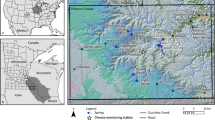Abstract
Groundwater is contaminated with chlorinated volatile organic compounds (CVOCs) including trichloroethene (TCE), tetrachloroethene (PCE), and their degradation products at a 230-acre formerly used defense site in Pennsylvania. Unconsolidated overburden materials ranging in thicknesses from 15 to 60 feet overlie two types of bedrock: quartzitic sandstone and phyllite on the eastern sloping hills and limestone and dolomite on the western flat-lying terrane. Karst is well developed in the carbonate rocks and is characterized by a pinnacle-and-cutter bedrock surface, solution-enlarged fractures/conduits at depths up to 450 feet below ground surface (bgs), caverns in tens of feet, and frequent occurrence of sinkholes. The PCE and TCE concentrations in groundwater samples suggest that dense non-aqueous phase liquid penetration extended to depths on the order of 400–450 feet bgs in the carbonate bedrock. A dye trace study was conducted to help refine the conceptual site model. The study consisted of five fluorescent dyes that were injected in five wells that encountered karst conduits/caverns at various depths from 32 to 216 feet bgs. The dyes were monitored at 40 monitoring wells and 16 points along a stream to the west of the site. The dye tracing results established positive dye detections at seven monitoring points in the stream. Field observations, infrared thermography imaging, and water quality survey confirmed that three of them, i.e., Spring-15, Spring-17, and Spring-26, are groundwater discharge points in the stream, i.e., submerged springs. Discovery of the submerged springs significantly contributed to the refinement of the conceptual site model and provided an opportunity to effectively remediate and manage the contaminated groundwater. These springs confirmed the exposure pathways that connect the site-impacted groundwater to surface water receptors, and the final remedy included measures to address potentially unacceptable risks to human beings and the environment in the stream and ensure that the state-regulated ambient water quality criteria are met for the site CVOCs at established compliance monitoring stations. These springs also helped optimize an existing pump and treat system that has been active since 1994. Shutdown and restart-up tests were conducted to evaluate the effectiveness of different extraction scenarios in the removal of the CVOCs at the springs under wet and dry seasons. The results led to a new configuration of the extraction wells by including a previously inactive extraction well CW-20.











Similar content being viewed by others
Data availability
The data presented in this study are available from the corresponding author upon request.
References
Ford D, Williams P (2007) Karst hydrology and geomorphology. John Wiley and Sons, Lt., 562 p
Green RT, Painter SL, Sun A, Worthington SRH (2006) Groundwater contamination in karst terranes. Water Air Soil Pollut Focus 6:157–170
National Research Council (1994) Alternatives for Ground Water Cleanup. National Academies Press, Washington, DC
Quinlan JF, Smart PL, Schindel GM, Alexander Jr. EC, Edwards AJ, Smith AR (1991) Recommended administrative/regulatory definition of karst aquifer, principles for classification of vulnerability of karst aquifers, and determination of optimum sampling frequency at springs. Proceedings of the 3rd Conference on Hydrogeology, Ecology, Monitoring, and Management of Ground Water in Karst Terranes, Nashville, TN, 4–6 December 1991, 573–635
Zhou W, Beck BF, Pettit AJ, Stephenson JB (2002) A ground water tracing investigation as an aid of locating ground water monitoring stations on the Mitchell Plain of Southern Indiana. Environ Geol 41:842–851. https://doi.org/10.1007/s00254-001-0464-0
Acknowledgements
The authors are grateful to the property owner who supports the publication of this article and to the project delivery team who collected all the data presented in this article.
Author information
Authors and Affiliations
Corresponding author
Additional information
Publisher's Note
Springer Nature remains neutral with regard to jurisdictional claims in published maps and institutional affiliations.
Rights and permissions
Springer Nature or its licensor holds exclusive rights to this article under a publishing agreement with the author(s) or other rightsholder(s); author self-archiving of the accepted manuscript version of this article is solely governed by the terms of such publishing agreement and applicable law.
About this article
Cite this article
Rafiee, H., Zhou, W., Zoeckler, J. et al. Discovery of submerged springs: a step forward to effectively remediate and manage contaminated groundwater in a karst aquifer. Carbonates Evaporites 37, 56 (2022). https://doi.org/10.1007/s13146-022-00800-6
Accepted:
Published:
DOI: https://doi.org/10.1007/s13146-022-00800-6




